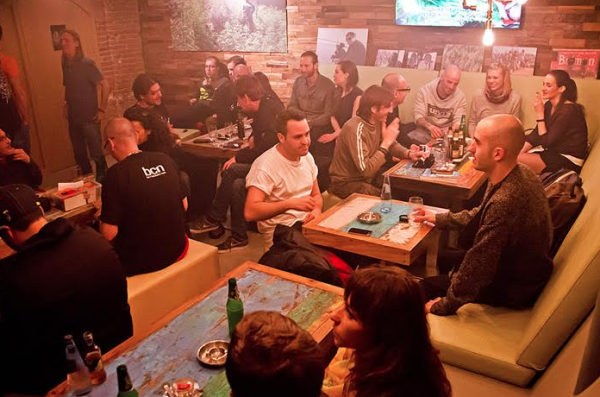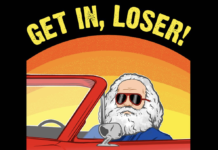
Public support for cannabis law reform is growing, and it seems inevitable that it will happen at some point. It’s no longer a question of should we change the law, what should we change it to and how soon?
Enter Dr Chris Wilkins of Massey University’s SHORE research center. He organised a drug policy conference last week in Auckland to help inform the debate and move it along. He has also proposed a new model for cannabis law reform in New Zealand: Cannabis social clubs in the form of Incorporated Societies (CIS), which would purchase cannabis products from a new Government agency, which has in turn licensed a variety of producers. The full version can be read at the New Zealand Medical Journal (behind a paywall) or watch the youtube video here.
The advantages are numerous:
- cannabis users can join the social club of their choice and have safe legal access to cannabis products;
- the cannabis products sold through clubs will be known strengths and dosages and free of harmful residues;
- cannabis social clubs are not-for-profit and will have social objectives such as providing harm reduction information to their members;
- clubs will only be accessible to adults aged over 18;
- CIS clubs could be established with only small tweaks to the licensing provisions of the Misuse of Drugs Act and the Incorporated Societies Act;
- the government cannabis agency collects revenue which can be used to offset the costs related to law enforcement, drug treatment and education;
- the agency can on-sell the cannabis to the Social Clubs at a price that is a better deal than the black market while detering excessive consumption;
- health promotion messages can be displayed on packaging and at the point of sale;
- cannabis from the social clubs will be distinguishable from illicit cannabis as they will be processed in some way (for example they could be ready rolled joints with logos and watermarks, child-proof vials of known-strength cannabis oil, lozenges made with fixed profiles of active cannabinoids, or pre-ground flowers ready for vaping);
- police can monitor licensed clubs while being better resourced to tackle any illicit sales.
This is a neat, cleverly thought out model that will satisfy the greatest number of concerns, bring in opponents, and creates very few problems compared to other models. Importantly, it gives us something to talk about. An idea to kick around and test out. It shows us what legalisation could look like in New Zealand. Is this how we want it?
My main concern is the proposed monthly limit of 28 grams (one ounce). That’s sufficient for most people, but it won’t be enough for heavy users and many medical users, who consume the largest amount but may be forced to abandon the legal social club system. Medical users are 42% of all cannabis users, or one in twenty people, and surveys of patients in US states where medical cannabis is legal show an average daily use of 1 to 5 grams, or 150 grams per month. Whatever we change the law to, it needs to minimise the size of the black market.
I’ve known Dr Wilkins for twenty years – his PhD used data from Aotearoa Legalise Cannabis Party members – and over the years we’ve had plenty of robust discussions about the options for cannabis law reform. I like to think I’ve alleviated some of his entirely valid concerns around the implications of making cannabis legal. I asked him why there was a limit at all, when there is no limit to the amount of alcohol or tobacco people can purchase. The answer was to be consistent with Uruguay, which has set a 28g monthly limit for cannabis club members. However in Uruguay cannabis consumers can also choose to grow their own or buy cannabis from pharmacies.
One of the world’s foremost experts in cannabis social clubs was in Auckland last week for a drug policy conference organised by Dr Wilkins and his team at Massey University. I talked to Prof. Dr. Tom Decorte, who has studied cannabis social clubs in Belgium, Spain and Uruguay at J Day in Auckland’s beautiful Albert Park. Under majestic century-old trees and surrounded by thousands of people openly consuming cannabis, I introduced Tom Decorte to two pioneers of cannabis social clubs in New Zealand. Dakta Green ran The Daktory while Jeanette Saxby operated the High Tea Cafe, both in West Auckland. Both have recently regained their freedom after being given custodial sentences for their part in the clubs. Tom Decorte told me that cannabis social clubs cannot solve the problems of the black market in isolation. “They are part of the solution. There must be the social clubs, there must be the home cultivation, and there must be the pharmacies.”
Dr Wilkins agrees. In a follow up email he told me “I think it would be consistent with overall principals of the approach to allow home cultivation without sale.” He also emphasised to me that the CIS model he outlined in the NZ Medical Journal is open to refinement, and suggestions for how to make it work better are welcome. I think it would be a huge improvement if medical users, their caregivers, and people who consume more than one ounce per month can also obtain it from pharmacies or grow their own.
The CIS model can be made better but there’s nothing I couldn’t live with. In the post-prohibition era, we’ll all need to make some compromises if we are to reach a consensus for law reform. What do you think? Leave a comment below, or head over to youtube – Dr Wilkins will be keeping an eye on the comments which he anticipates “could be really useful to develop the regime further.”






It will be a golden goose for some future government.
I’m sorry, I have some concerns about this as a model. This idea has been floated with its main objective, to avoid BIG CANNABIS from taking hold over New Zealand Cannabis sales.
This requires there being, big Government Cannabis which in turn is grow by big private contractors.
It has been stated that high pricing will be maintained, through high product pricing and a high TAX levied on products. This I believe will not do anything as a disincentive, in dismantling the black market.
The club model also states that only weaker forms of Cannabis will be available to club members. this I believe will do nothing to remove the black market and may even strengthen it, as a by product.
If you were to adopt this reasoning to Alcohol, would only offering low Alcohol beverages remove harms of Alcohol? or in turn stimulate a new, illegal, higher strength Alcohol market.
This proposed club model almost seems to presume there’s no market place operating already and that these are new products to be offered, where no market already exists.
There is also reference made to products containing high THC as bad Cannabis and CBD rich ones as being the good kind of Cannabis.
This is just not the case and as the fight to establish medical products progressed, the main stream media has only portrayed high CBD Cannabis products as having medical value, while this is just not the truth in regards to, Cancer and pain relief for patients.
While I seriously want to see a new way of thinking adopted around Cannabis. I really don’t want to see a poorly thought out model that still penalizes responsible users of Cannabis, for what ever their motives may be, Medical or recreational.Or do we have a model that overcharges, arrests users for smoking over Vaporizing or jails a person for taking care of their own needs by growing a couple of plants because they can,just like they may grow their own vegetables and don’t for whatever reason want to join a club.
Please don’t think I’m knocking the idea of new approaches to the Cannabis market place, as it’s well overdue. But there really needs to be informed debate over this model and I don’t believe the club idea really has enough going for it, over other models of legal Cannabis regulation. When all concerns can be addressed without clubs of Cannabis users being formed.
Are the growers and sellers of what is proposed as Government sold Cannabis, not seen to be able to be regulated in a way that doesn’t just involve the Government as a regulator and Tax collector.
Very true. And poor youth out of work will still need to rob to get their weed to self medicate their ADHD’s or PTSD’s.
So a doctor can give you harmful SSRI for $5 a month, but less harmful cannabis will cost you an arm and a leg and force you into crime!
High price’s and a profit model do many harms, much like excessive use. This is not harm reduction at work!
The idea of liquid or mulched buds worries me too, as who knows what else could be added without a consumer knowing.
Sativex contains the preservative glygol [a carcinogen], for no reason! 99% alcohol tinctures last for decades without the need for a preservative, and why choose such a harmful one like glycol?
It will probably be safer to buy elsewhere.
Cannabis keeps too many people employed, gangs, police, SERCO, justice department personnel, doctors, physchologists the list goes on, decriminalise cannabis and you take the value out of the product, it aint rocket science, we are all being poisoned these days by the multinationals who are putting additives in our food products.
Politicans need to grow a brain on this issue?
No way will punters be paying top dollar for a low strength product.
At least there will be lots of contacts at the club to get full strength, better quality and better value product.
Why pay more for watered down grog?
And people who smoke low strength cigarettes, usually suck harder and smoke more and do more harm to their lungs. This is not harm reduction at work!
If you really want harm reduction the best option is high strength hash! One little puff compared to four or five damaging puffs of buds.
Who are these twits?
In the video Dr Chris Wilkins states high THC causes psychosis.
This hoary old chestnut is just so unscientific, and not true.
Where are these psychotic stoners? I have not seen them in any clubs, or any videos of 420 rallies in the states, etc etc, they are all mellow and cops have no problems. Check long time users like Whoopi Goldberg, Bill Mayer, Bob Marley et al….
If your looking for psychotic behavior go no further than alcohol!
AND anti-depressants! Check the website ‘SSRI stories’ to see all the harm done by big harma medication, the spree shooters, murderers and suicides who were medicated with anti-psychotics or SSRI from their doctor for $5 a month!
But I do support non smoking styles of administration and uptake, oil is so easy to make, as easy as making a cup of coffee.
Also the issue of heavy metals.
Colorado does not test for heavy metal contamination, but Washington does, and Washington testers reject approx 20% of product supplied by contractors as unsafe due to harmful residues.
Heavy metal toxicity is the primary cause of mental illness, as well as contributing to other disorders. And smoking burnt buds increases heavy metals in the body 10 fold compared to sublingual [via mouth mucousa, tongue and gums] or via the stomach and liver as in edibles or drinks.
Again, hash has fewer contaminants and is much safer than buds of any strength, and hash can then be processed into a non smoking form.
Yes I agree GONZO and one of the key factors that encourages the smoking of Cannabis over safer delivery methods, is prohibition.
The simple fact is, with the premium high prices being paid for good quality raw Buds, users are looking for bang for their bucks and this has led to many users, smoking Chop as well ( Tobacco mix ).
I think many people see Hash and oils as being stronger therefor not as safe, this however is not the case and is dose specific as to what form of Cannabis is being used.
In the US, some reports say extracts, in the form of Dabs and vaporizing has taken 30% of the market place already and when you add edibles to the mix it”s clear to see that usage is changing without laws, demanding a certain kind delivery of Cannabis.
When people are thinking about building a new platform to take Cannabis away from an already established Black-Market. One very obvious question must be asked, What do the end consumers want? If you don’t factor this in, how on earth do you sway them away from the networks they’ve relied upon for decades.
Comments are closed.